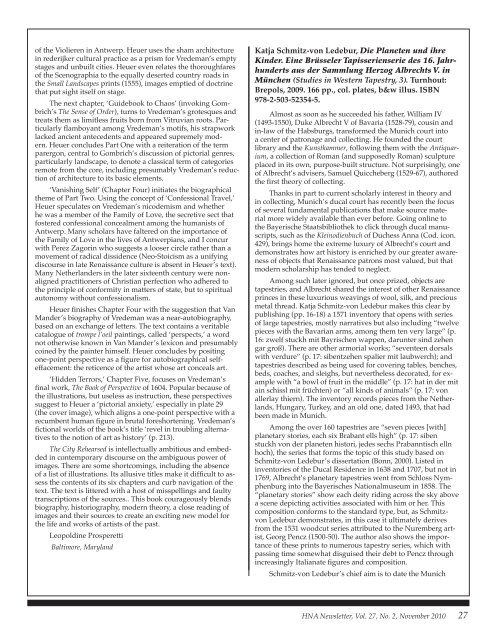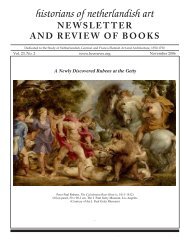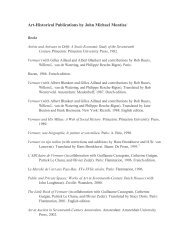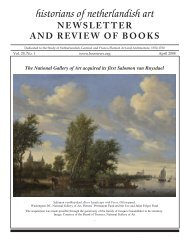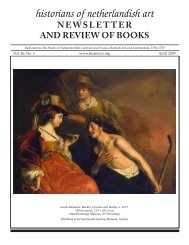newsletter - Historians of Netherlandish Art
newsletter - Historians of Netherlandish Art
newsletter - Historians of Netherlandish Art
You also want an ePaper? Increase the reach of your titles
YUMPU automatically turns print PDFs into web optimized ePapers that Google loves.
<strong>of</strong> the Violieren in Antwerp. Heuer uses the sham architecture<br />
in rederijker cultural practice as a prism for Vredeman’s empty<br />
stages and unbuilt cities. Heuer even relates the thoroughfares<br />
<strong>of</strong> the Scenographia to the equally deserted country roads in<br />
the Small Landscapes prints (1555), images emptied <strong>of</strong> doctrine<br />
that put sight itself on stage.<br />
The next chapter, ‘Guidebook to Chaos’ (invoking Gombrich’s<br />
The Sense <strong>of</strong> Order), turns to Vredeman’s grotesques and<br />
treats them as limitless fruits born from Vitruvian roots. Particularly<br />
fl amboyant among Vredeman’s motifs, his strapwork<br />
lacked ancient antecedents and appeared supremely modern.<br />
Heuer concludes Part One with a reiteration <strong>of</strong> the term<br />
parergon, central to Gombrich’s discussion <strong>of</strong> pictorial genres,<br />
particularly landscape, to denote a classical term <strong>of</strong> categories<br />
remote from the core, including presumably Vredeman’s reduction<br />
<strong>of</strong> architecture to its basic elements.<br />
‘Vanishing Self’ (Chapter Four) initiates the biographical<br />
theme <strong>of</strong> Part Two. Using the concept <strong>of</strong> ‘Confessional Travel,’<br />
Heuer speculates on Vredeman’s nicodemism and whether<br />
he was a member <strong>of</strong> the Family <strong>of</strong> Love, the secretive sect that<br />
fostered confessional concealment among the humanists <strong>of</strong><br />
Antwerp. Many scholars have faltered on the importance <strong>of</strong><br />
the Family <strong>of</strong> Love in the lives <strong>of</strong> Antwerpians, and I concur<br />
with Perez Zagorin who suggests a looser circle rather than a<br />
movement <strong>of</strong> radical dissidence (Neo-Stoicism as a unifying<br />
discourse in late Renaissance culture is absent in Heuer’s text).<br />
Many Netherlanders in the later sixteenth century were nonaligned<br />
practitioners <strong>of</strong> Christian perfection who adhered to<br />
the principle <strong>of</strong> conformity in matters <strong>of</strong> state, but to spiritual<br />
autonomy without confessionalism.<br />
Heuer fi nishes Chapter Four with the suggestion that Van<br />
Mander’s biography <strong>of</strong> Vredeman was a near-autobiography,<br />
based on an exchange <strong>of</strong> letters. The text contains a veritable<br />
catalogue <strong>of</strong> trompe l’oeil paintings, called ‘perspects,’ a word<br />
not otherwise known in Van Mander’s lexicon and presumably<br />
coined by the painter himself. Heuer concludes by positing<br />
one-point perspective as a fi gure for autobiographical selfeffacement:<br />
the reticence <strong>of</strong> the artist whose art conceals art.<br />
‘Hidden Terrors,’ Chapter Five, focuses on Vredeman’s<br />
fi nal work, The Book <strong>of</strong> Perspective <strong>of</strong> 1604. Popular because <strong>of</strong><br />
the illustrations, but useless as instruction, these perspectives<br />
suggest to Heuer a ‘pictorial anxiety,’ especially in plate 29<br />
(the cover image), which aligns a one-point perspective with a<br />
recumbent human fi gure in brutal foreshortening. Vredeman’s<br />
fi ctional worlds <strong>of</strong> the book’s title ‘revel in troubling alternatives<br />
to the notion <strong>of</strong> art as history’ (p. 213).<br />
The City Rehearsed is intellectually ambitious and embedded<br />
in contemporary discourse on the ambiguous power <strong>of</strong><br />
images. There are some shortcomings, including the absence<br />
<strong>of</strong> a list <strong>of</strong> illustrations. Its allusive titles make it diffi cult to assess<br />
the contents <strong>of</strong> its six chapters and curb navigation <strong>of</strong> the<br />
text. The text is littered with a host <strong>of</strong> misspellings and faulty<br />
transcriptions <strong>of</strong> the sources.. This book courageously blends<br />
biography, historiography, modern theory, a close reading <strong>of</strong><br />
images and their sources to create an exciting new model for<br />
the life and works <strong>of</strong> artists <strong>of</strong> the past.<br />
Leopoldine Prosperetti<br />
Baltimore, Maryland<br />
Katja Schmitz-von Ledebur, Die Planeten und ihre<br />
Kinder. Eine Brüsseler Tapisserienserie des 16. Jahrhunderts<br />
aus der Sammlung Herzog Albrechts V. in<br />
München (Studies in Western Tapestry, 3). Turnhout:<br />
Brepols, 2009. 166 pp., col. plates, b&w illus. ISBN<br />
978-2-503-52354-5.<br />
Almost as soon as he succeeded his father, William IV<br />
(1493-1550), Duke Albrecht V <strong>of</strong> Bavaria (1528-79), cousin and<br />
in-law <strong>of</strong> the Habsburgs, transformed the Munich court into<br />
a center <strong>of</strong> patronage and collecting. He founded the court<br />
library and the Kunstkammer, following them with the Antiquarium,<br />
a collection <strong>of</strong> Roman (and supposedly Roman) sculpture<br />
placed in its own, purpose-built structure. Not surprisingly, one<br />
<strong>of</strong> Albrecht’s advisers, Samuel Quiccheberg (1529-67), authored<br />
the fi rst theory <strong>of</strong> collecting.<br />
Thanks in part to current scholarly interest in theory and<br />
in collecting, Munich’s ducal court has recently been the focus<br />
<strong>of</strong> several fundamental publications that make source material<br />
more widely available than ever before. Going online to<br />
the Bayerische Staatsbibliothek to click through ducal manuscripts,<br />
such as the Kleinodienbuch <strong>of</strong> Duchess Anna (Cod. icon.<br />
429), brings home the extreme luxury <strong>of</strong> Albrecht’s court and<br />
demonstrates how art history is enriched by our greater awareness<br />
<strong>of</strong> objects that Renaissance patrons most valued, but that<br />
modern scholarship has tended to neglect.<br />
Among such later ignored, but once prized, objects are<br />
tapestries, and Albrecht shared the interest <strong>of</strong> other Renaissance<br />
princes in these luxurious weavings <strong>of</strong> wool, silk, and precious<br />
metal thread. Katja Schmitz-von Ledebur makes this clear by<br />
publishing (pp. 16-18) a 1571 inventory that opens with series<br />
<strong>of</strong> large tapestries, mostly narratives but also including “twelve<br />
pieces with the Bavarian arms, among them ten very large” (p.<br />
16: zwelf stuckh mit Bayrischen wappen, darunter sind zehen<br />
gar groß). There are other armorial works; “seventeen dorsals<br />
with verdure” (p. 17: sibentzehen spalier mit laubwerch); and<br />
tapestries described as being used for covering tables, benches,<br />
beds, coaches, and sleighs, but nevertheless decorated, for example<br />
with “a bowl <strong>of</strong> fruit in the middle” (p. 17: hat in der mit<br />
ain schissl mit früchten) or “all kinds <strong>of</strong> animals” (p. 17: von<br />
allerlay thiern). The inventory records pieces from the Netherlands,<br />
Hungary, Turkey, and an old one, dated 1493, that had<br />
been made in Munich.<br />
Among the over 160 tapestries are “seven pieces [with]<br />
planetary stories, each six Brabant ells high” (p. 17: siben<br />
stuckh von der planeten histori, jedes sechs Prabanntisch elln<br />
hoch), the series that forms the topic <strong>of</strong> this study based on<br />
Schmitz-von Ledebur’s dissertation (Bonn, 2000). Listed in<br />
inventories <strong>of</strong> the Ducal Residence in 1638 and 1707, but not in<br />
1769, Albrecht’s planetary tapestries went from Schloss Nymphenburg<br />
into the Bayerisches Nationalmuseum in 1858. The<br />
“planetary stories” show each deity riding across the sky above<br />
a scene depicting activities associated with him or her. This<br />
composition conforms to the standard type, but, as Schmitzvon<br />
Ledebur demonstrates, in this case it ultimately derives<br />
from the 1531 woodcut series attributed to the Nuremberg artist,<br />
Georg Pencz (1500-50). The author also shows the importance<br />
<strong>of</strong> these prints to numerous tapestry series, which with<br />
passing time somewhat disguised their debt to Pencz through<br />
increasingly Italianate fi gures and composition.<br />
Schmitz-von Ledebur’s chief aim is to date the Munich<br />
HNA Newsletter, Vol. 27, No. 2, November 2010<br />
27


